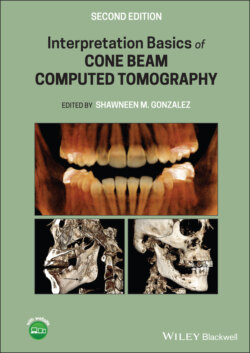Читать книгу Interpretation Basics of Cone Beam Computed Tomography - Группа авторов - Страница 9
Preface to the Second Edition
ОглавлениеIt is the goal of this book to help practitioners and students gain a better understanding of anatomy and common disease processes that frequently present on cone beam computed tomography (CBCT) scans. This book seeks to fill the gap in the current literature where little is presented on common radiographic appearances on CBCT. In addition to this book, there are sample cases with videos online at www.wiley.com/go/gonzalez/interpretation, where you can practice working your way through regions and entire scans using the knowledge you acquire in this book.
The beginning of the book covers general information about different CBCT unit parameters and recommended uses from specialty organizations. The third chapter covers legal considerations of owning a cone beam CT, referring patients for a cone beam CT scan, and/or interpreting cone beam CT scans in the United States. This information is lacking in the current literature and is something many professionals should be aware of before purchasing or using a cone beam CT unit.
Each book chapter from the fourth chapter on is an anatomical region covering the topics of anatomy, common anatomic variants/developmental anomalies, pathosis, and other findings. The first regions presented are the paranasal sinuses and mastoid air cells and nasal cavity and airway, which are intimately involved with each other. The anatomy section covers pertinent anatomy to evaluate when interpreting or reviewing a scan. The next section covers common anatomic variants with various images showing how they appear on axial, coronal, and sagittal views. The last section covers commonly seen disease processes, such as sinusitis, that should be noted on a written radiology interpretation.
Chapter 6 is on the cranial skull base and orbits. There are many anatomical landmarks in the cranial skull base such as canals, foramina, air cells, and more, making this a difficult region to interpret. Key anatomy is shown on various views (axial, coronal, and sagittal) to aid CBCT users in orienting themselves on the scan.
All soft‐tissue findings are moved into one chapter. There is no anatomy as CBCT is a hard‐tissue imaging modality. All findings are listed as pathosis or other findings and appear as calcifications in the soft tissues.
The region of the cervical spine covers anatomy to disease processes such as degenerative joint disease. Degenerative joint disease is progressive with multiple appearances based on the degree of bony damage. This chapter has many example images of degenerative joint disease at various points in the disease process.
The last region covered is the temporomandibular joints, which is very thorough thanks to the contributions of Gayle Reardon, who has studied and continues to study this region in depth. The temporomandibular joints have a unique set of disease processes and developmental appearances beyond arthritic changes. This chapter covers entities CBCT users should be aware of even if they are not seen in daily practice.
The appendix shows example written reports of CBCT scans to view and consider when writing radiology interpretations.
